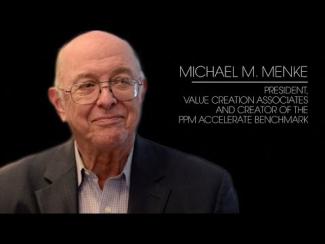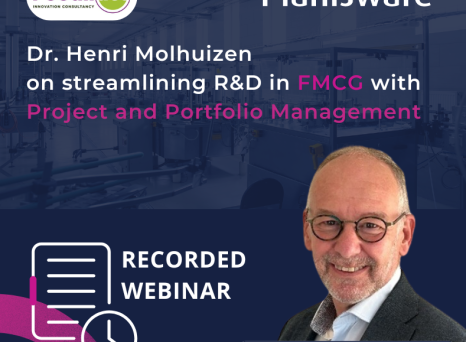X
How was the PPM Accelerate Benchmark born?
That is a really interesting multinational story.
I was invited in 2010 to give a keynote speech at a portfolio management conference in the Netherlands. And there I met a number of people, including representatives of a European pharmaceutical company which was a subsidiary of an American company, as well as a number of PPM consultants.
And shortly after that conference the European pharmaceutical company decided they wanted to do some benchmarking of their own portfolio management process and contacted one of the Dutch companies, who contacted me and said: "Would you like to join with us and bring in North American participants in the benchmarking study?"
So it's a very international story. And we had 30 organizations participate in the first year in 2011, and have added almost... I'd say slightly over a hundred subsequently in the years that followed.
What surprised you most about the results of the PPM Accelerate Benchmark?
Well, one of the things that surprised me a great deal – and particularly given that there are a number of PPM software vendors, of which Planisware is certainly one of the leading ones – and their tools seem to emphasize a lot of ways to manage resources.
And yet when you ask about best practices for resource management such as: "Do not overload your pipeline with too many projects.", people agree: "We know that we shouldn't do that but we're doing that anyway." "Management is always asking us to do more with less." etc. etc. So, despite all of the tools out there, people are not... know they're not managing their resources as well as they should.
But there's also been in the PPM field much talk about the importance of aligning your portfolio with your strategy. And PPM... Using PPM as a key tool for strategic execution. And yet when you ask organizations "How well is your portfolio aligned with your strategy?" most organizations – even some of the best industry groups like pharmaceuticals – say: "Our strategic alignment is weak."
So, two of my biggest surprises were: the weakness in resource management and the weakness in strategical alignment.
What impact has the PPM Accelerate Benchmark had on companies that participated?
I'll describe several. One company – and in fact since they've let me publicly use their name, Unilever – was able to gain a lot of credibility with their top management by showing them how they compared to comparable fast moving consumer goods companies in the study. And they compared quite favorably with some of their rivals. And that established a lot of credibility for the Portfolio Management Group at Unilever with senior management at Unilever. So that was one very good impact for them.
Another medium sized European pharmaceutical company did the benchmark, found out where they were weak, made changes in their process and came back a year later and said we want to take the benchmark again to see if we've improved. And indeed they were pleasantly surprised and they had improved quite a bit of the way.
Another company – an agricultural chemicals company which was one of the leaders in our whole benchmark exercise – they had lots and lots of practices they were doing really well, nonetheless found that they had areas where they could improve. One area was in increasing their focus and prioritization on those projects that just barely made it into the portfolio, and those projects that just barely didn't make it. They used to spend their time talking about all the projects, and they refocused the scarce management time and prioritization discussion on those that were really close to being in or being out of the portfolio.
A final example of impact is a large multinational pharmaceutical company learned that they were not communicating very well about portfolio management. So they organized a communication exercise where the CEO of the worldwide pharmaceutical unit did an interview with their internal employee newsletter. And told all of the employees – some 4,000 to 5,000 worldwide – why this is important, how we, as the executive committee, use the results, and we really appreciate the effort that you all go to help us get that information, which we need for decision making.
What has changed or not changed in the portfolio management space over the last 35 years?
What has changed I think is the number of companies that are participating in PPM. And even just sitting at the lunch table today, many of the companies said they were relatively new to Planisware. So even though Planisware has been around a long time, and PPM has been around a long time, new companies are coming on board. So that's a really good trend.
On the other hand, since we're still weak in resource management, and since we're still weak in strategic alignment, many of the things that you would think people would have in a sense improved and mastered in these 30 to 35 years still seem to be areas of opportunity for improvement.
So, more companies are becoming aware. I think portfolio management is gaining in credibility. But people are slow to move and to use the latest and most powerful techniques.
What are your hopes for the field of portfolio management in the coming years?
Well one of my particular areas of interest, and I will be talking about it later this afternoon in a workshop, is the whole area of portfolio optimization. Now, this relates very much to the interesting field of prioritization that we touched upon before.
But if you think of the old legend of Robin Hood: he was someone who took from the rich, who had more than they needed, and gave to the poor, who had less than they needed. Now think of projects in your own portfolio: There are some that may have more resources than they really need, and are not getting the best marginal benefit out of those resources. There are other projects that may be underfunded: who knows, perhaps the project manager is very shy and doesn't ask for what he or she really needs, and therefore is drowned out by a very pompous project manager from another project who gets more than here than she really needs.
So I'd like to see the resources possibly redistributed from the projects that are over-resourced to those that are under-resourced and can really greatly increase in value.
And there are techniques to do this. Planisware has some of those techniques available, but I'm told that not too many of the clients subscribe to those modules. And there are some even more advanced techniques that can be installed in Planisware, and implemented by customers if there is demand.
I tend to call that by the nickname "the efficient frontier", portfolio optimization approach. So one of the reasons I'm here at the conference, and one of my hopes for the future, is to help people understand portfolio optimization, the value that's there, and hopefully some of the companies will adopt and begin to use that, and take advantage of those benefits.
What is the "efficient frontier" in the context of portfolio management?
Well, the efficient frontier... It's the highest value portfolio you could find if you moved resources away from the projects that are not making the best use of them and reallocated those resources to the projects that can make better use of them. And, well, I would love to say you can make a curve like this that shows: "Here's our portfolio today." And you can make a curve like that, much higher value per unit costs expended. And the efficient frontier would be essentially the highest such curve that it's practically possible to create.
Can the ROI of portfolio prioritization be calculated?
It's very difficult to trace the impact of portfolio management at the R&D stage to the ultimate financial results of the company. Because marketing and manufacturing have to do their part, and if R&D does let's say a great job on a certain product but it isn't made well or doesn't sell well R&D could say: "That's someone else's fault that we didn't get the value.”
But the industry where R&D has the most direct impact on sales and profitability is the pharmaceutical industry. They depend very heavily on new, significant products being developed to sustain their growth and profitability.
And we've actually studied the stock price over time for the companies that are doing the best portfolio management compared to the entire pharmaceutical industry including those that are doing the best but those that are not. And over a 7 to 8 year period you can see a significant difference in the stock price.
And I actually include that graphic in my Planisware talk, the keynote tomorrow morning.
How to use benchmarking when newly appointed as head of portfolio
Using benchmarking to diagnose portfolio management processes
Obviously if you come into any new organization as the responsible executive you'd like to know what are the strong points and what are the weak points of the organization for which you now have responsibility.
The benchmarking that i'm gonna talk about tomorrow morning is clearly a very quick and inexpensive way to get your hands around how does your organization look compared to others in your industry. So, well it's certainly not the only way to do it, benchmarking is something I would recommend to that person.
And in fact I have recently recommended it to a potential new client for the benchmarking that has a new executive who's come in – exactly the situation you describe – and she was from project management, but is not all that familiar with portfolio management.
So, by participating in the benchmarking study, she has an opportunity: 1) to learn about a broader set of practices that apply to portfolio management as well as project management. And 2) to see how her organization compares to other pharmaceutical companies, and where [are] the greatest areas that she might want to make improvements, and make her mark, and add to the value of the company.
Using benchmarking to help with the merger of two organizations
This organization I just mentioned had another feature: it's a pharmaceutical company that acquired a fairly large biotech company. And each of those organizations have their own portfolio management process. So not only do they have the job of comparing their strengths and weaknesses to other organizations. They also want to form an integrated "best-of-both" process, because they're now trying to merge the traditional pharmaceutical group with the traditional biotech group – two somewhat different backgrounds – into a single unified corporate process. And the benchmark again as a marvelous tool to help them do that.
How does the PPM Accelerate Benchmark relate to last year's keynote speaker, Dr. Robert Cooper?
Well, we in our benchmarking have a set of 50 best practices. But those best practices we did not invent them. We, in a sense, aggregated them from lots and lots of prior research.
And in fact one of the most important R&D project portfolio management benchmarking studies was conducted by Dr. Robert Cooper, last year's keynote speaker and his colleagues back in the 1990s with the Industrial Research Institute. And one of the best practices - in fact our very first best practice among the 50 - is "Accept the three overarching objectives of project portfolio management." #1: Strategic alignment, #2: Strategic balance, and #3: Maximum return. Those are basically 3 chapters out of Cooper's book "Portfolio Management for New Product Development". So, we've very openly borrowed and taken the best we could find of previous best practice research, and integrated that into our best practice categories.
Maximum return
Now it's interesting to go back to Cooper's three objectives. I think most people have an idea of what maximum return means. "I have a fixed head count. I have a fixed budget. How do I get more good business results out?" That's, in a sense, maximizing financial return. But part of Cooper's research said: If you only run your portfolio to maximize financial return, you'll actually not achieve the best business results.
And that's why the other two objectives are there: strategic alignment and strategic balance. These two, [it's] a little less clear what they actually mean than maximum return. You don't have a nice handy financial metric to measure.
Strategic balance
Of these, the least tangible if you will, the hardest to get your hands around is: What is strategic balance? And I like to say balance is like beauty: it's in the eye of the beholder. Each person can look at the portfolio from his or her point of view and say: "Does that seemed well balanced to me?"
For example an executive vice president at Hewlett-Packard where I worked for a number of years said: "I want to make sure that 10% of R&D is on really new breakthrough projects. You can take the 90% and improve the current products. Make minor modifications. Make significant modifications. But let's spend 10% on the breakthroughs that will make our future." That was part of his idea of maintaining a balance between the long-term, the medium term, and the short term.
You can think of balance as where management gets a little wiggle room. They can say: "Look, this is what I think we have to do. Let's set up a bucket for those early stage projects. Let's set up a bucket for developing country pharmaceuticals, vaccines to save children in Africa." Whatever it might be that wouldn't make the cut on pure profitability, but will make us a better company. So that's a bit about balance.
Strategic alignment
Now, strategic alignment. That seems a little more tangible. And yet as I said elsewhere in this interview, companies admit: "We're not doing a very good job of it. We don't quite understand how to do it."
Some people think you can inspect strategic alignment in. In other words, you can create a portfolio and then test it for strategic alignment. And in the quality movement, they show that you cannot inspect quality in to a product with a lot of defects. You have to design the defects out, in the beginning. Where the analogy here in project portfolio management is: you need to build strategic alignment in. In the creation of projects that will execute and implement your strategy. Not try to inspect later whether you included them.
So I very much believe that strategic alignment has to be driven on the front end of creating the set of projects for consideration, which are only then subjected to value and balanced testing.
Of the 50 best practices, what would be your top 2 favorite ones?
Well I'd say one is practice A1: Cooper's 3 overarching objectives.
And perhaps my second favorite is in the Resource Management category: "Do not overload your pipeline."
Every company says "I know that's very important but unfortunately we're overloading our pipeline." Why? Because a vice president comes in and says: "This project is very important." And sales director comes in and says: "This customer needs something." And so we have to do it even though our people are already fully committed.
And when we do that, everything slows down. All of the projects come too late. No one is very happy. We need to make set priorities and make clear decisions. And if we're going to try and do more, we need to allocate more resources, more money, more people to get the job done.



